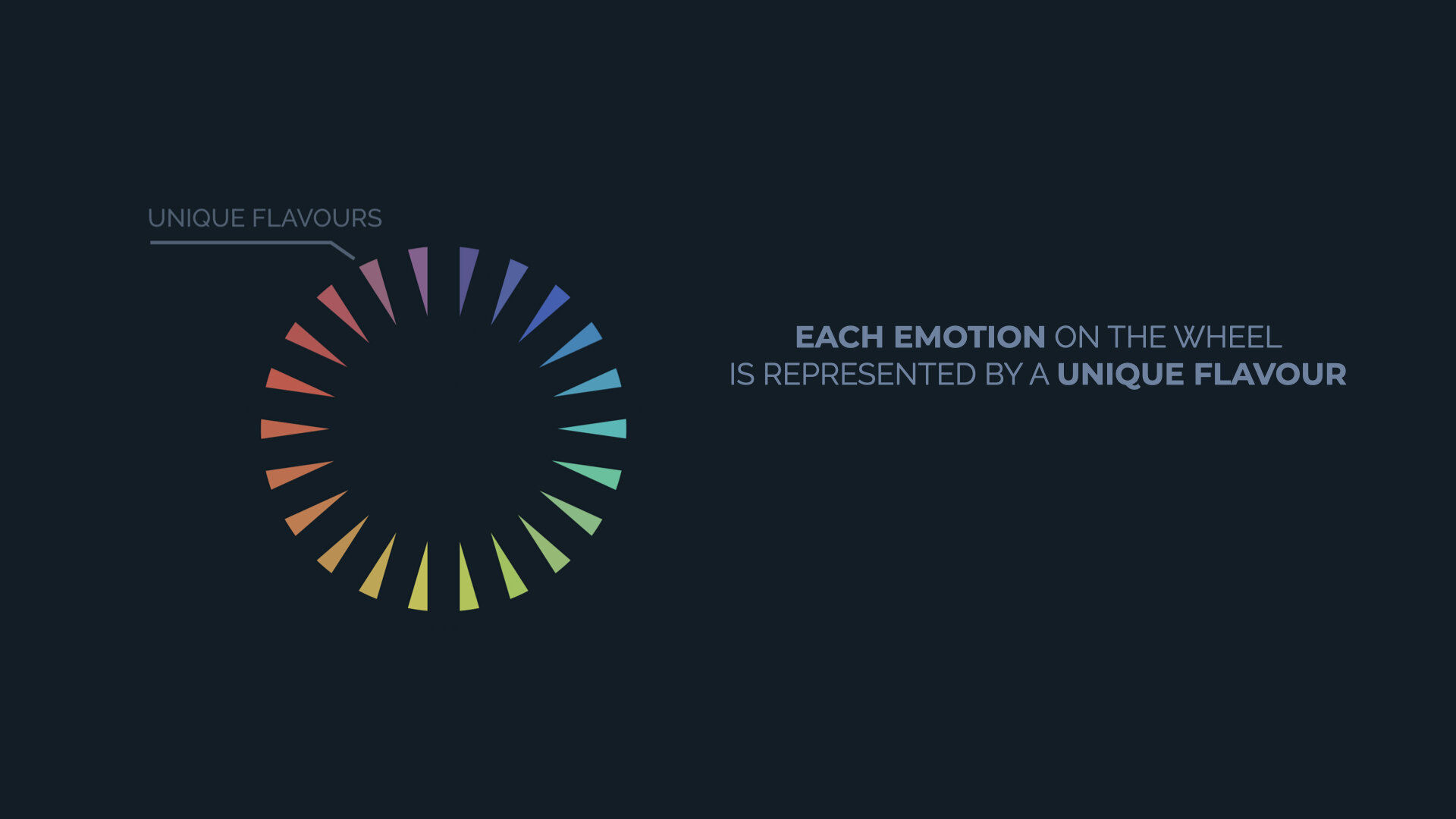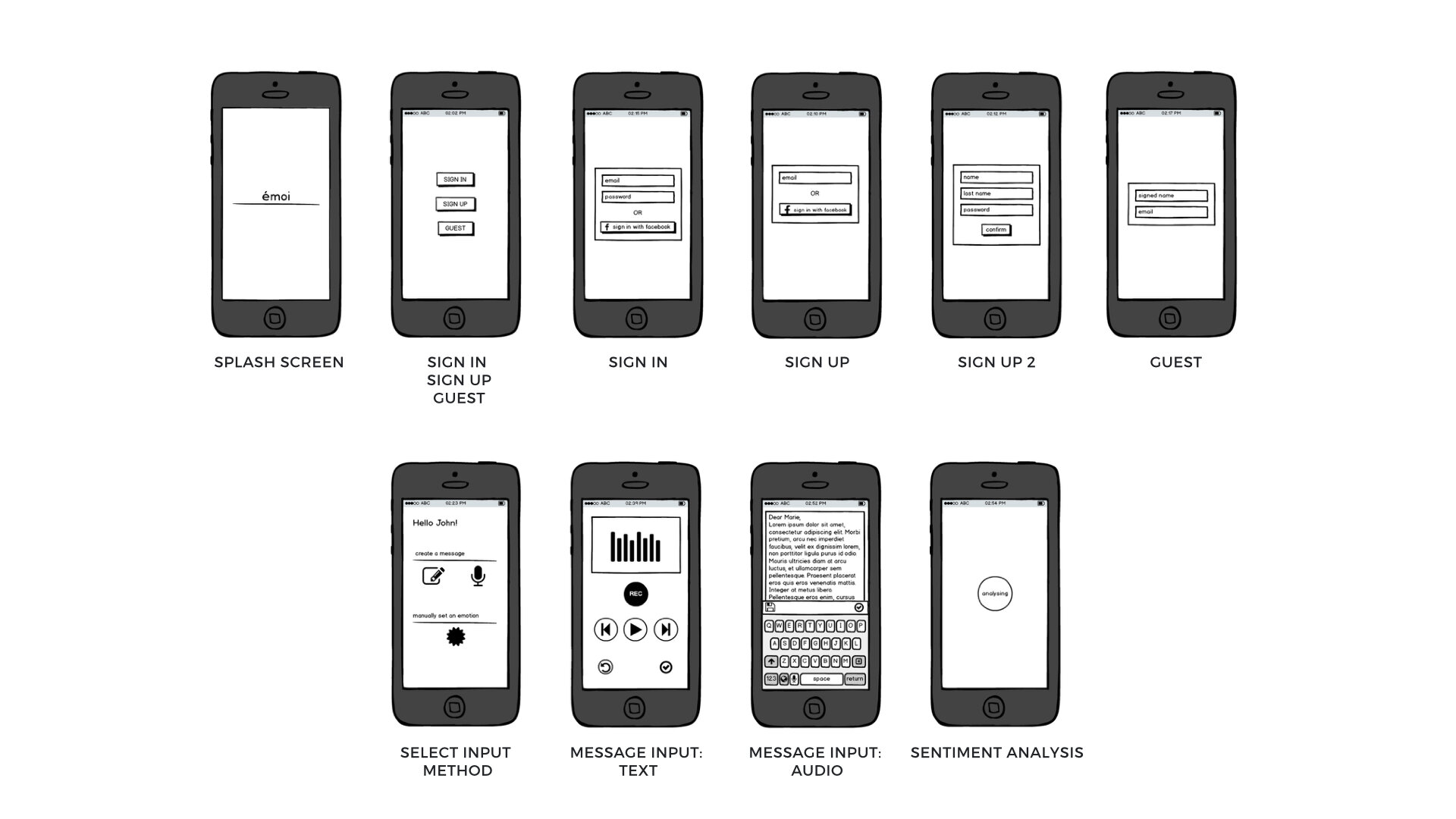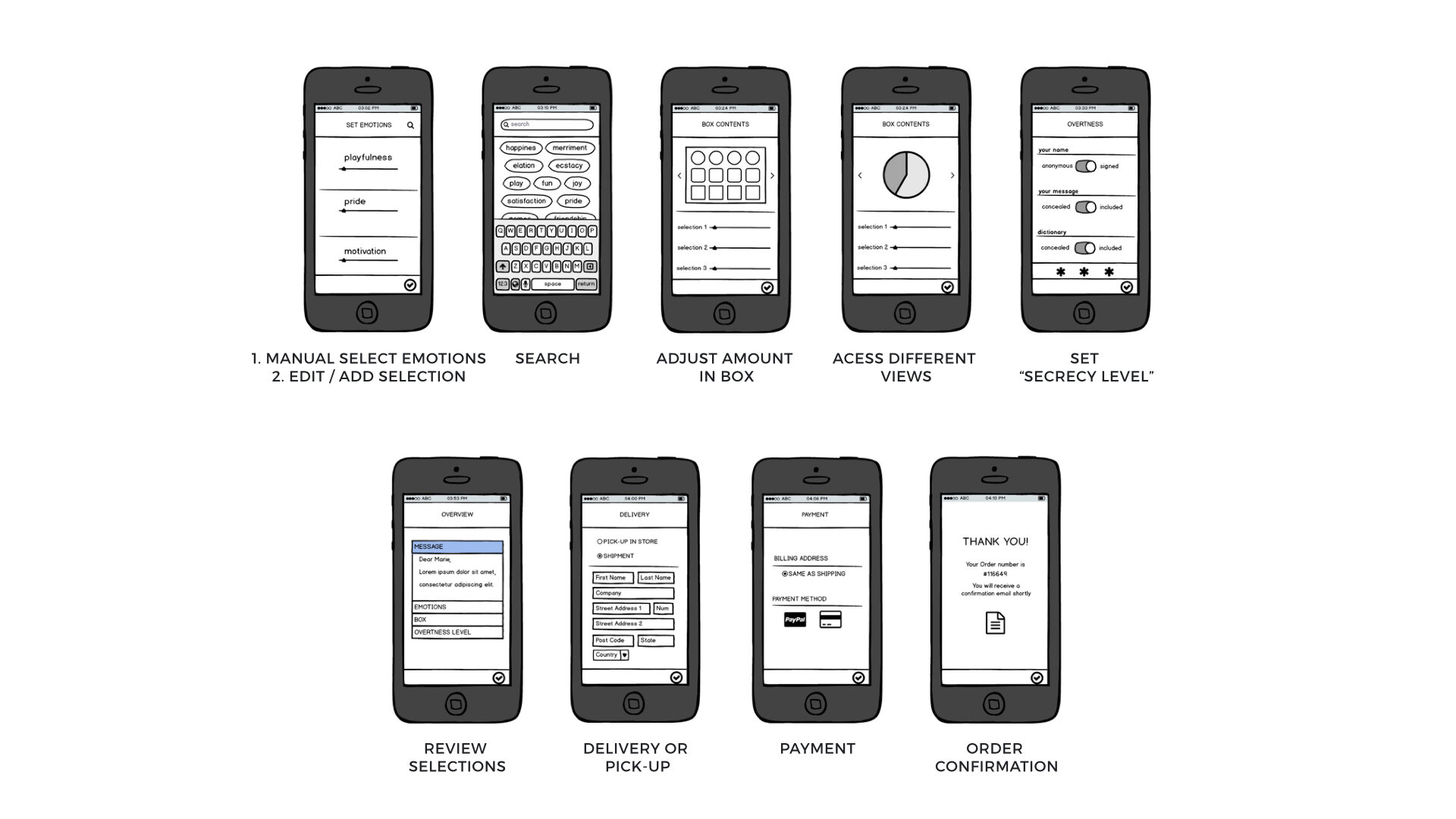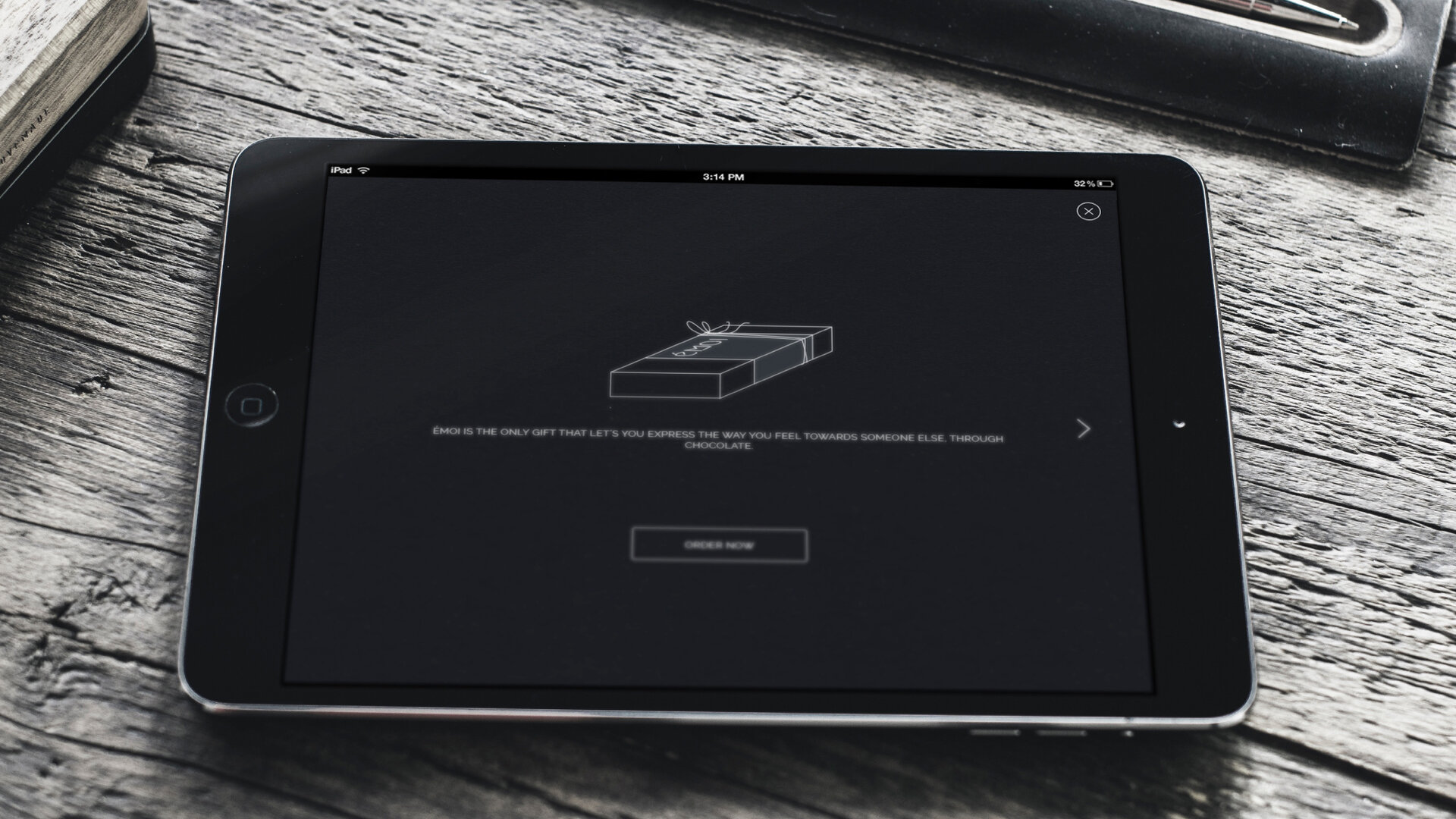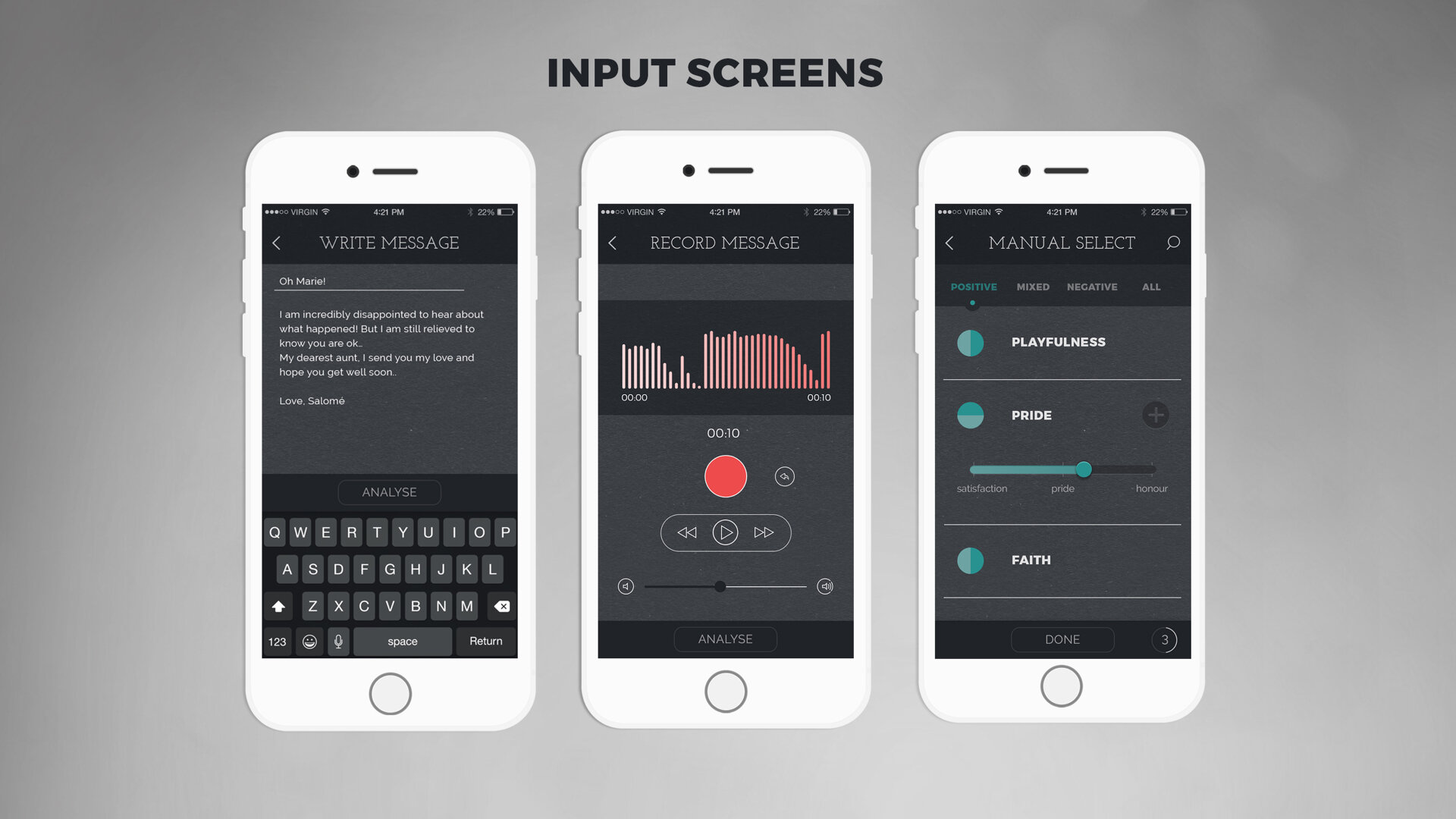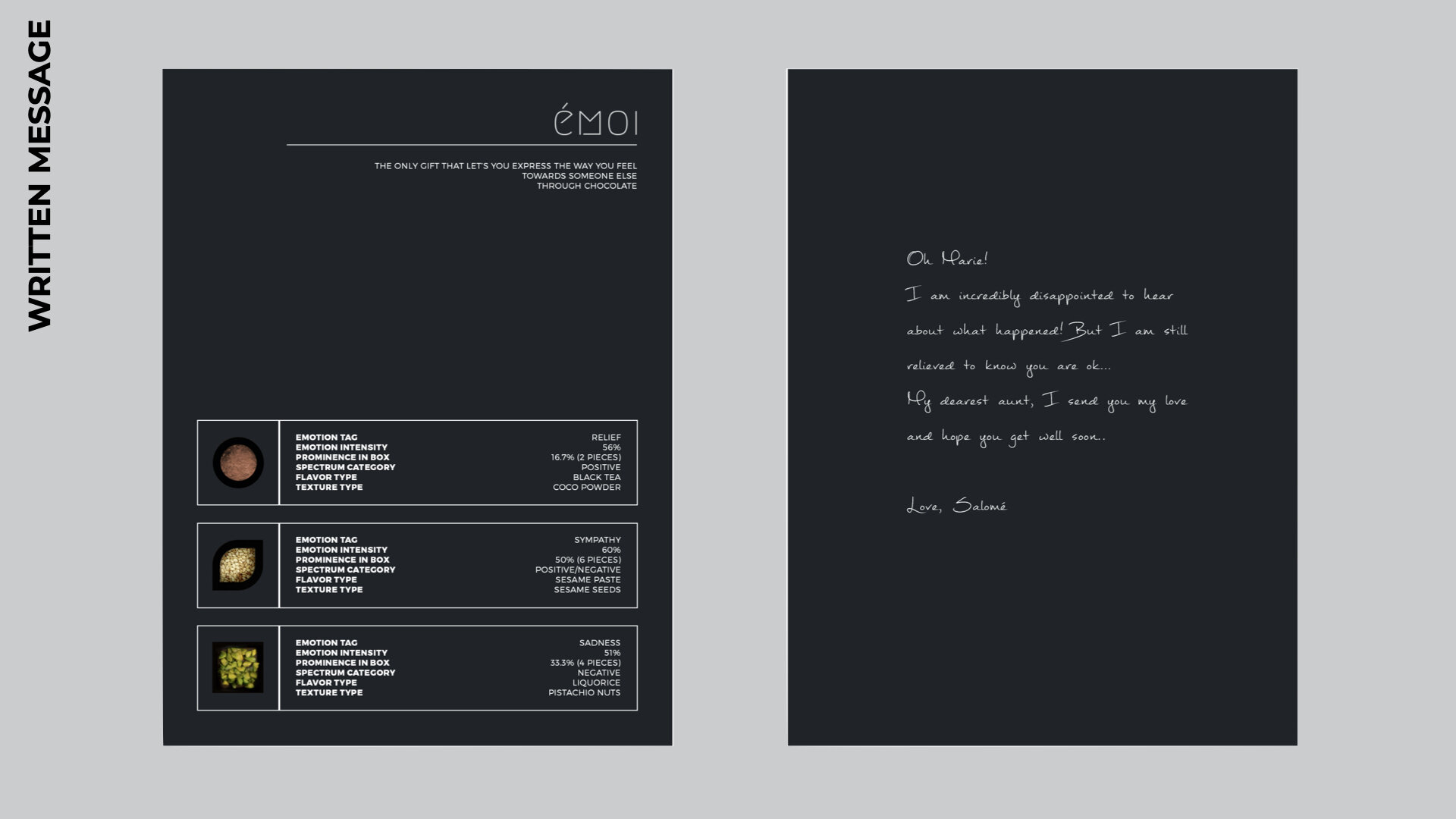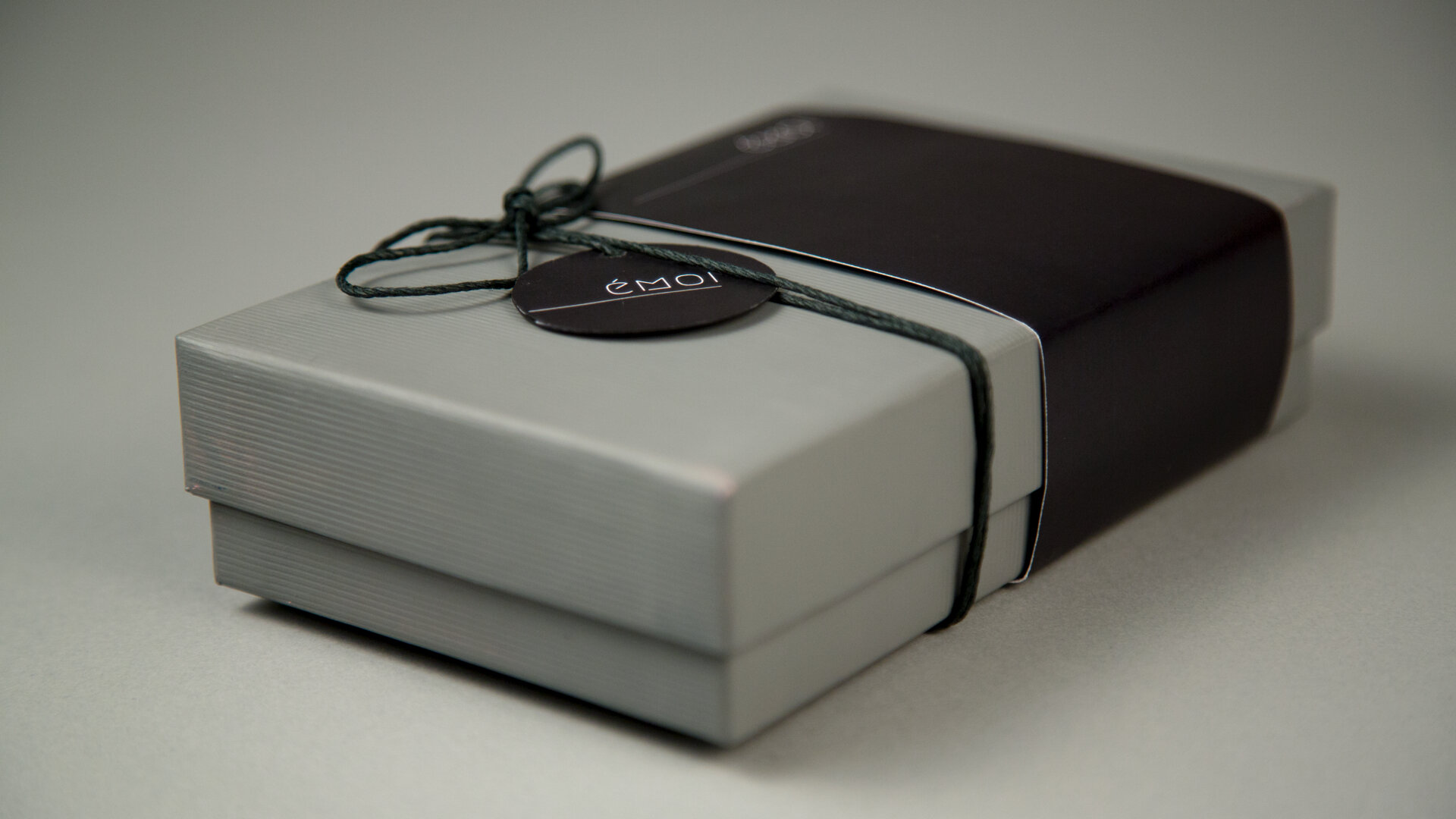And here’s a selection of work that showcases my broad skill set in user experience, interaction design, content development, visual design and programming!
01
Emoi
Designing a near-future physical and digital product
An exploration of multimodal communication through an edible chocolate-based language. This concept was developed independently for my IxD master’s program thesis.
Research, UX, UI & Service Design
Section overview
The overview
“émoi” is a service and "data gustation" interface that allows users to communicate their feelings through an edible chocolate-based language using qualities of taste, texture, shape and colour.
The concept uses a variety of digital systems (ie. e-commerce, sentiment analysis algorithms) to reinvent the long-standing tradition of sharing and gifting chocolates as an expression of interpersonal feelings and exchanges.
This edible representation of the user’s emotions is created using a communication language based on research into multimodal systems and the human gustatory and oral somatosensory experience.
Role throughout project
This project was carried out independently.
Design research - prototyping - UX/UI/interaction design - service design
Content design - content production - content writing
Communication - storytelling - copywriting
Media production - motion design - visual design - audio production
The tools used were
Primary, secondary and tertiary sourced research
Literature review
Competitor / state-of-the-art analysis
User research
Desk research
Interviews
Scenarios
Personas
Prototyping
User flow
System design
Service blueprinting
Storytelling
Awards
Core77 Design Awards 2016 "Student Notable" in Speculative Concept
Shortlisted for IxDAwards 2016
Events
News
20 minuti, Svizzera
●
The brief
The project was produced as part of my master’s thesis. The assigned brief was to define and answer a research question and hypothesis.
The general direction I chose to work on was to imagine a near future world / product / service.
The project’s point of departure was to explore senses other than the visual modality as a way of communicating and representing data. I relied on a breadth of existing research into multi-sensory communication to investigate the possibilities alternate mediums had to offer.
My findings lead me to tackling one of the lesser used mediums as an exploration in speculative design: taste. Taste is versatile and multimodal in itself too, combining elements of smell and haptics through its texture or “mouthfeel”.
Through researching the possibilities and applications for this concept, I eventually arrived at the final form of the project - ‘visualising’ human sentiment through chocolate as an edible medium.
Research question
Signals present in the natural world convey messages, changes in states, as well as illustrate alarm mechanisms. Can such features be used to implement multi-sensory modes of communication that go beyond the screen and standard notification systems?
Hypothesis
It is highly probable that data representation can be effectively communicated through “natural” signals since our bodies have evolved to interpret and understand these signals over millennia.
●
Exploring the literature
The first step in answering my research question and defining my project direction involved diving into the existing literature on the topic of multi-modal forms of communication.
Our modern world tends to default on communicating to us visually. But research shows that multi-modal methods of “display” are not only more effective, but that we humans are in fact naturally better equipped at interacting with our world multi-modally.
The studies referenced also revealed that there truly is a capacity to create languages through diverse multisensory systems. And so a future where we can receive and understand digital data languages using a diverse set of sensory receptors may indeed be a conceivable near future.
There is a wide variety of research that explores the possibilities of multimodal interfaces in complementing or surpassing visual GUIs in usability and effectiveness.
GUIs fall short of embracing the richness of human senses and skills people have developed through a lifetime of interaction with the physical world.
- Hiroshi Ishii, MIT professor and Tangible UI pioneer
Signalling theory
“Only humans invent and design their own communication environment [and] it is only recently that we have been creating wholly invented contexts for our communication.”
-Judith Donath
In her 2007 publication in the MIT Press entitled “Signals, cues and meaning,” Judith Donath uses signalling theory to discuss how new technologies shape communication and the social world. This theory of evolutionary biology states that, at its very core, our living planet and its inhabitants rely on an eclectic range of explicit and implicit signals that inform and shape our world and its continuous evolution. This intrinsic communication takes place in the form of expressions between persons, mating calls of animals in their habitat, or even trees shedding their auburn leaves to bloom with flowers again the following season.
With the most recent technological explosion, we’ve created a multitude of new digital environments, from mobile computing, to online video chat, to video games and multiplayer role-playing games, each with their own particular toolbox of signals and conventions.
(Not so)ubiquitous computing
Our digital products are still in the infancy of their potential - unable to take into account considerations like context or medium to make communicating with us and our other devices as natural as nature itself.
As early as the 90s, barely at the cusp of the internet age, the team at Xerox PARC were discussing the limitations and possibilities a networked world would be bringing us. Even back then, there was already talk about how our display systems are too divorced from one another and from the environment and spaces in which they existed.
Mark Weiser, one key figure in that Xerox PARC team and a man who is considered to be the father of ubiquitous computing, described this in his seminal publication “The Computer of the 21st Century.” He states that “the most profound technologies are those that disappear. They weave themselves into the fabric of everyday life until they are indistinguishable from it.” Just as with driving, the more we get used to understanding the processes and signals involved, the more the tasks become second nature and disappear into the periphery. Weiser considered this concept to be the key to realizing the seamless integration of “ubiquitous computing”.
He likened the state of computing at the time of publication to how writing was once a “new technology” available only to a select number of scribes. Whereas “today this technology is ubiquitous in industrialized countries. Not only do books, magazines and newspapers convey written information, but so do street signs, billboards, shop signs and even graffiti. […] The constant background presence of these products of "literacy technology" does not require active attention, but the information to be conveyed is ready for use at a glance.”
Though we have come a long way from the time of his paper’s publication, the merging of our devices with our environments has not yet reached that state of indistinguishable seamlessness he describes. Yes, the world is more connected than ever, but there is still a distinct lack of “calm,” unobtrusive integration between our devices and spaces that allows things to “disappear” into the background. Yes, the world is more digital than ever, but it seems each one of our devices is still awkwardly screaming for our attention like a child that hasn’t yet learned how to speak.
The argument for multimodal display systems
Today’s GUI systems do not take advantage the diversity of human sensory capabilities, a set of skills that has evolved through eons of interaction to best engage and interact with the natural world that surrounds us. This is the crux of what MIT’s Hiroshi Ishii and many of today’s leading thinkers attest to.
Mark Weiser also noted that “[…] although ubiquitous computers may employ sound and video in addition to text and graphics, that does not make them "multimedia computers." Today's multimedia machine makes the computer screen into a demanding focus of attention rather than allowing it to fade into the background”. “Even the most powerful notebook computer, with access to a worldwide information network, still focuses attention on a single box,” he said.
Indeed, the screen-only interface system is a transitional one at best. As interface designer and future of technology researcher Bret Victor states in his “Brief Rant on the Future of Interaction Design”, suggesting that GUIs on screens are the technology of the future “is like claiming that black-and-white is the future of photography. It's obviously a transitional technology. And the sooner we transition, the better”.
This is why I chose multisensory display systems as the topic for the future digital communication method I would explore - a place where colours, textures, tastes and sensations are coded with information to form a language. Just as today’s billboards and signs now carry “codes” that we collectively understand.
Using haptics to create a multimodal language
Tangible interfaces can be intuitively coded to create a multisensory language. For example, a researcher exploring haptic visualization explores using nominal (qualitative) and ordinal (quantitative) values to communicate and access data. She discusses how shapes, patterns and orientations can be effectively used to define ‘tangible IDs’ to assign names to groups or types of data, and how all other non-shape related variables can be used to express ordinality (order). Examples of this include the use of resistance on a door to portray the “accessibility” level a person is given when entering a space, or levels of vibration that convey seismic activity levels of an earthquake.
The human haptic system can process a complex variety of tactile variables that can be cutaneous (touch) or kinaesthetic (body movement). Cutaneous senses include mechanoreceptors that can interpret changes in patterns and pressure as well as differences in vibration types like flutter, buzzing, or thermoreceptors that can recognize variations in temperature. These cutaneous elements can also be identified visually using variables like size, shape, texture/grain, orientation, and elevation. While kinaesthetic variables can produce sensations that include resistance, friction, and kinaesthetic location.
Sensory substitution
The future of our experiences may utilize our body’s “input sources” and our brains powerful processing capability to decipher new communication messages from our surroundings. This scenario’s plausibility is supported by recent breakthroughs in research areas such as “sensory substitution” where participants with auditory and vision impairments can regain perception by learning sensory languages communicated through haptic, auditory and impulse devices transmitted through unconventional parts of their body.
There are, for example, already deaf individuals who can decipher “sound messages” using a vibration language through a custom-made vest, blind persons who can “see“ with their tongue and a monochromatic man who can’t see any colour at all but hear them instead.
The "Bouba/Kiki Effect"
To explore how multisensory communication can be applied to a cross-modal language I referred to work of researcher Charles Spence of Oxford University into something he called the “Bouba/Kiki Effect”. The “Bouba/Kiki Effect” is a phenomenon where people were shown to consistently associate specific letter pronunciation sounds with specific shapes. The basic idea behind the “Bouba/Kiki Effect” is that people generally associate vowels like those present in the word “Bouba”, which create a round-shaped mouth and widen the vocal tract in pronunciation (a, o, u), with round amoeba-like shapes. While vowels like those in the word “Kiki” that stretch our lips out horizontally and narrow our vocal tract (i, e) are associated with sharp, polygon-like shapes.
Most importantly, the“Bouba/Kiki Effect” has been shown to take place in the taste modality too. For example, “Bouba” has been commonly associated with sweet flavours, while “Kiki” was more linked to bitter tastes. Apparently, people had also consistently identified mint chocolate as being more "kiki" than regular chocolate”.
This particular piece of research was applied in “Kitchen Theory,” a multimodal experiment in cuisine, where Spence, along with Chef Jozef Youssef, created presentations that applied “bouba/kiki” to food. They experimented with flavour, colour, shape, texture as well as sound. The chef’s creation is based on a study of participants from China, India, Malaysia, and the USA that found that participants consistently associated colour and flavour values. Black was associated with bitter, green with sour, pink with sweet, and white with salty.
Kitchen Theory’s Chef Jozef Youssef preparing a multisensory meal experience
Exploring the medium
The next step in defining my project direction involved selecting an appropriate medium based on the previous research investigation findings.
Why the gustatory system
I chose to focus on the gustatory sense in particular because it is uniquely multisensory. While in the mouth, it engages taste as well as more “haptic” sensations - also called our somatosensory system. This includes variables like texture and temperature. At the same time food lies in the tangible world so the classic haptic variables like moisture, texture, and temperature can be engaged using the hands too. And of course, food also inherently carries olfactory attributes - so you can perceive it through smell. All these elements could work together to create a complex multidimensional experience produced through a gustatory display.
Why chocolate
Chocolate takes full advantage of the gustatory experience’s multimodal capacity. Unlike other foods with either subtle or very specific flavours, chocolate comes in many flavours, texture, and colours that can all further lend themselves to a multimodal visualization of the data.
Chocolate is also easily accessible and loved by people in general. People are familiar with what it should taste like and it is eaten by the majority of the population. And though it is used to celebrate and commemorate occasions, its context transcends any one particular situation; it can be served with a meal, with a coffee or just as a snack, at home, in the office or at an event. It also does not impose a certain time for its serving and can be eaten multiple times a day.
As a medium, chocolate is also inherently easy to manipulate compared to other foods which may require complicated and extensive cooking processes. Chocolate can also be easily mixed with a variety of ingredients. It is also relatively easy to transport and to store.
Finally, I thought it would be very interesting to address the long-standing, long known relationship between food and mood. Our emotions have a unique connection with our food experience. Whether it be how customs and traditions seem to always be centred around food, or our eating habits relating to psychology (think self soothing and comfort food). And chocolate has historically been a key player in this relationship.
Concept development and definition
The following step in researching my project direction was the ideation and iteration phase. Using a survey and a series of user interviews I was able to pinpoint which areas of my initial ideas worked and which didn’t work. This was key to developing and improving upon the concept. And through more user and industry expert interviews I was able to further refine the final project concept.
Ideation and iteration phase 1
Concept: Team cognition
The initial concept’s main idea was to use multimodal visualization through the chocolate to tackle “team cognition” and promote positive team dynamics in the workplace. The chocolates would represent:
The internal emotion: the collective sentiment of the members of a team
Team performance: the effectiveness of the team’s performance
The external emotion: the collective sentiment of audience, customers or followers
The system would eventually aggregate enough data to be able to have some predictive capacities and a general ability at measuring the “health” of the team and their output capacity.
Sketch of the “Team Cognition” concept
Syntax: The Dimensional Approach
I researched an emotion representation language to serve as the basis of the communication syntax I could use for the concept. In this iteration, the system would use an emotion to flavour language based on Wilhelm Wundt’s (1905) “dimensional approach” which divides the emotional spectrum into three basic dimensions of valence, arousal and tension to cover the diverse range of experienced emotions. This would be used in conjunction with the aforementioned “bouba/kiki effect”.
An investigation of how the “Dimensional Approach” could be applied to create an edible language.
Ideation and iteration phase 2
Concept: Edible news reactions
The second concept’s aim was to create a simple interface that could teach users about the multisensory visualization based the gustatory sense. The user would input a news topic by scanning it from their phone or a newspaper and an algorithm would mine online comments related to the topic to calculate the audience’s dominant sentiment towards the topic to produce an appropriate chocolate combination.
Sketch of the “Edible News Reactions” concept
Syntax: The Geneva Emotion Wheel
For this concept I explored a different emotion representation language that seemed more appropriate for the context. Here I referenced an emotion to flavour language based on Klaus R. Scherer’s “Geneva Emotion Wheel” which gets more specific than the previously mentioned dimensional approach. Again, this would be used in conjunction with the “bouba/kiki effect” concepts.
An investigation of how the “Geneva Emotion Wheel” could be applied to create an edible language.
User research and feedback findings
User interviews
I tested the initial concepts in 2 phases, one for each concept.
The first phase included a survey on how people would interact with such a product in the workplace.
The second phase included interviews with potential users.
Survey: 22 participants
Interviews: 8 participants
Interviewees found the “Team Cognition” concept difficult to understand.
They found that the “Edible News Reactions” concept didn’t fit the medium - what does news and the general public’s “emotion” have to do with chocolate?
They found that chocolate is more likely associated with personal, one-to-one emotional experiences that occur in more direct and intentional interactions between people.
Interviewees and prospective users described how they found the idea of communicating one’s emotion to others through chocolate intriguing.
“It would be so intriguing for people to discover emotions of bosses or peers through the shape and taste of a chocolate”
- Interview participant
Industry expert interviews
I interviewed 4 chocolate artisans and 1 hotelier consultant in the local industry to gain valuable insights into their behaviours and needs and those of their customers.
Chocolate has an ability to invoke experiences of deep emotions in people.
Artisanal chocolates in particular are given as presents in special occasions, holidays and celebrations, to express affection, greetings, or condolences.
Chocolate artisans separate themselves from mainstream products through ingredient quality, creation creativity and uniqueness, and an ability to customize and personalize chocolate design and flavours.
Chocolate artisan spotlight: Tristan Carbonatto
Tristan has been running his artisanal chocolate shop for 17 years, and he is passionate about his art. He says that the art of chocolate is an emotional experience for both him and his clients. He particularly loves experimenting with the diverse possibilities available in creating chocolate.
His creations of include dark chocolate, milk chocolate, and white chocolate. But he also explores intriguing and exciting combinations created after multiple experiments and trials and errors with a diverse variety of ingredient.
He’s created chocolates with sea salt, peppers, chillis, and sesame, ginger, green tea, mint, and many more - which he keeps stocked among many other ingredients in the back of his shop for an endless choice of variety.
Ideation and iteration phase 3
Concept: Émoi, a gifting service that uses flavour and mouthfeel to communicate feelings and messages
I developed this concept iteration to take into account my research and interviews findings. Since artisanal chocolate’s natural context and function is in the form of a gift offered personally in special occasions, It would make most sense for a visualization of emotions through chocolate to be part of this experience too. By displaying the emotional state of its ‘user’ in the form of chocolate, an emotionally expressive, personalised and unique experience is created for both the sender and the recipient.
●
Onliness statement
User and client definition
The client is
Chocolate ateliers and artisans.
The users are
Persons exchanging gifts during a variety of occasions and situations.
The client needs
A new and innovative way to engage with their clients.
A way to modernise and innovate in a traditional industry.
The users need
Added meaning and thought to a normally mundane gift.
Scenarios
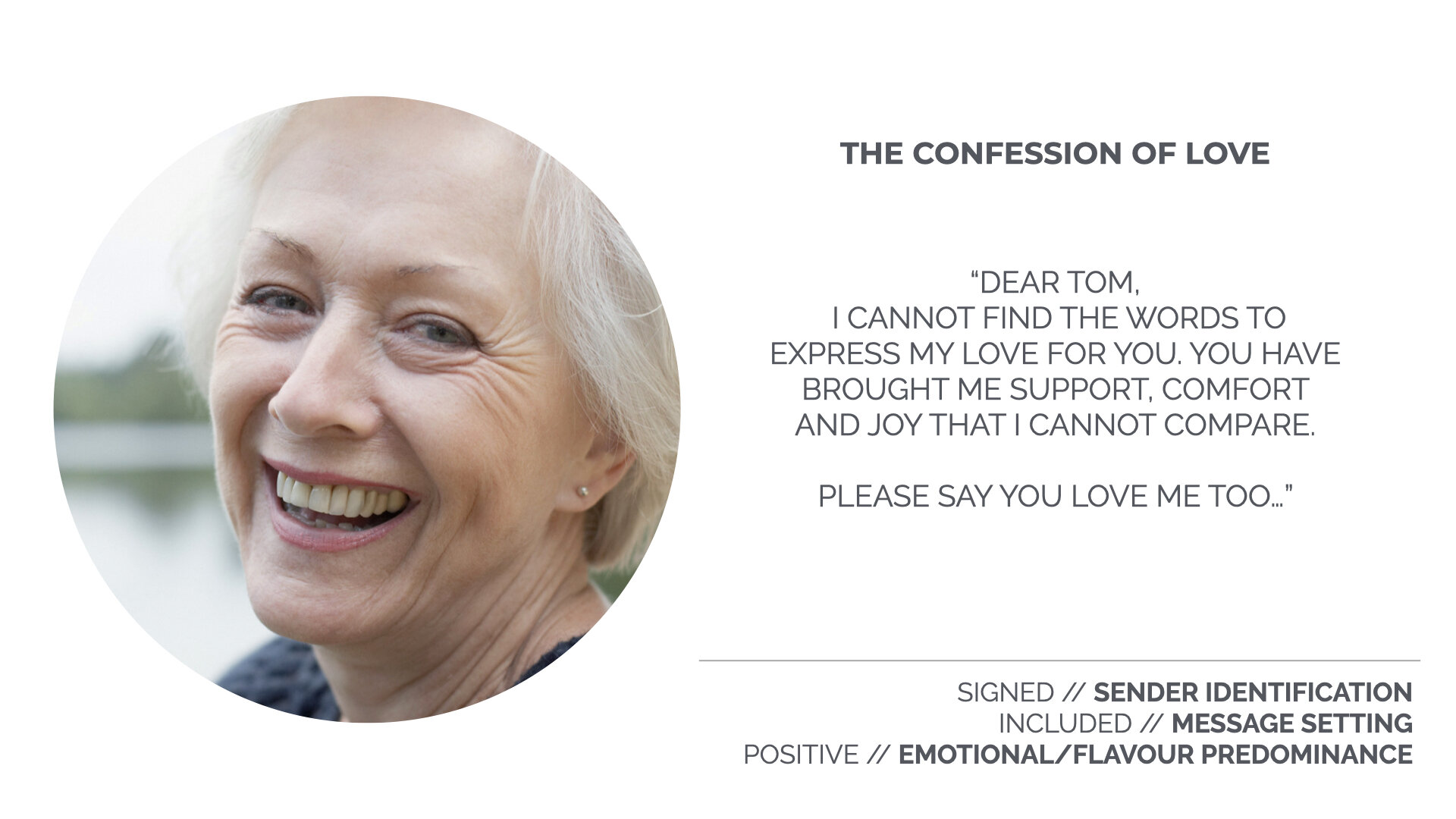
Claire orders a box of émoi online and picks it up in store. She uses it to express her love to Tom.
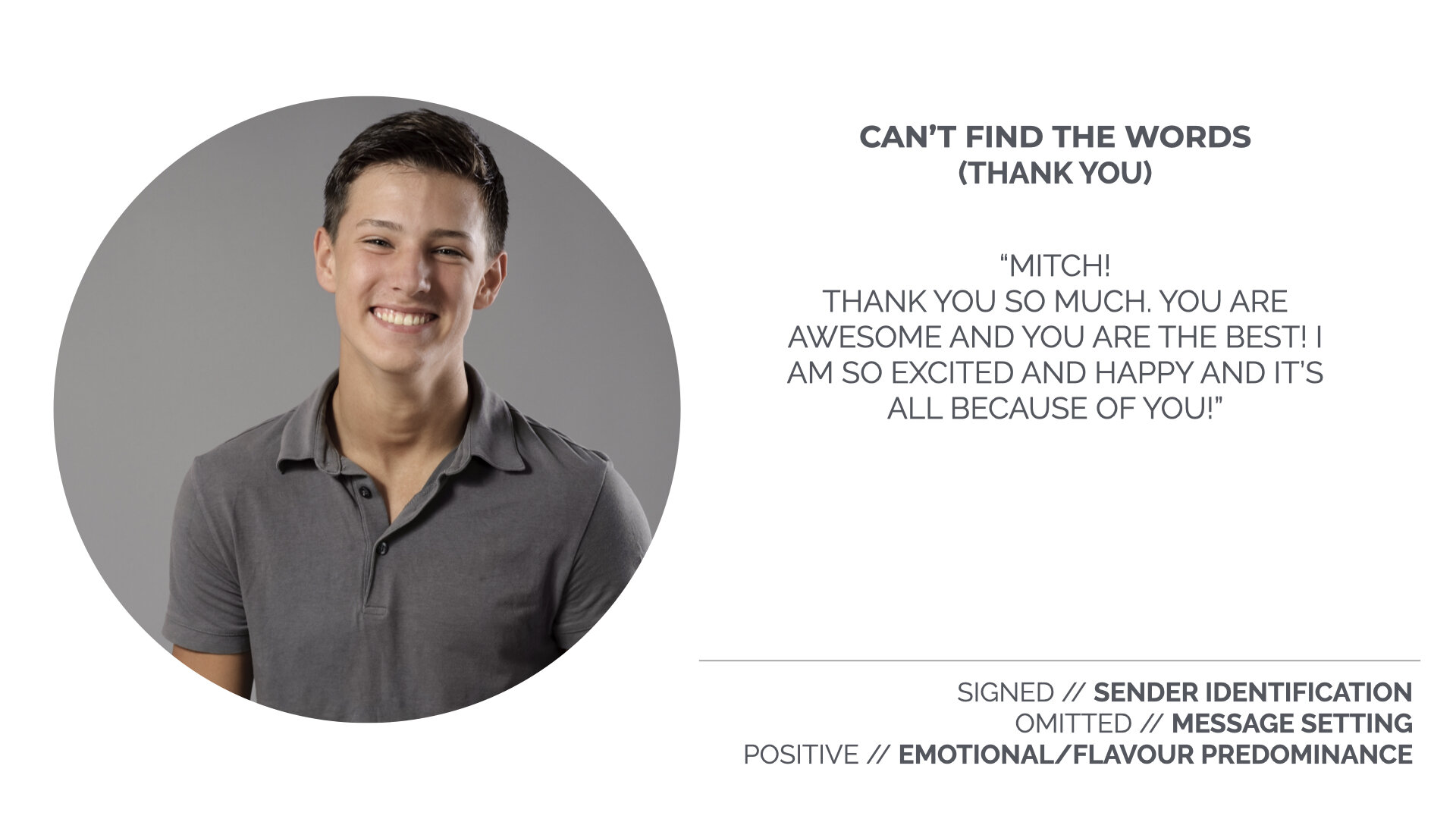
Hiroshi didn’t come with his translator, but can still express his respect and gratitude on completing this business deal by presenting Jerome a box of émoi.
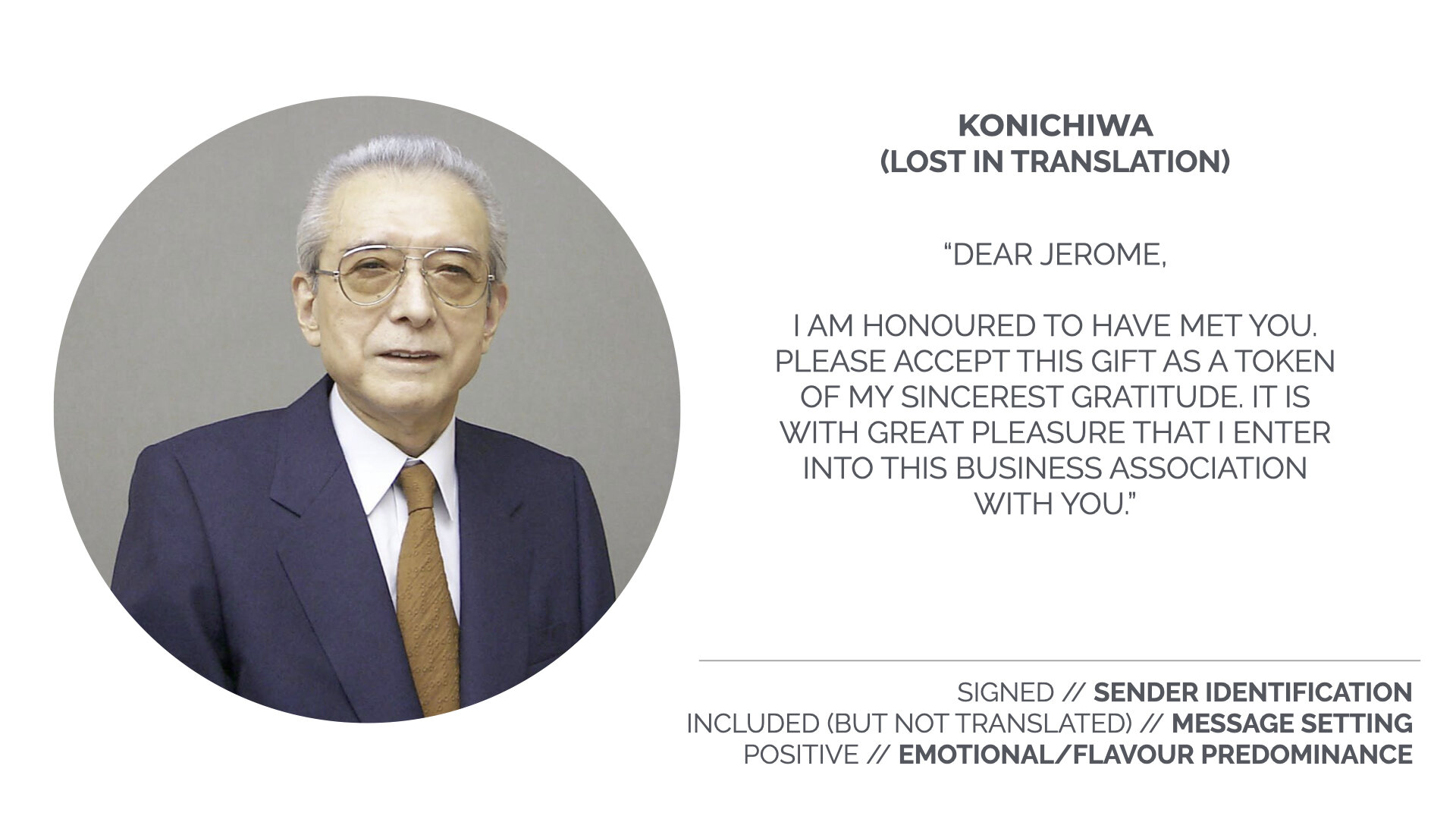
Hiroshi didn’t come with his translator, but can still express his respect and gratitude on completing this business deal by presenting Jerome a box of émoi.
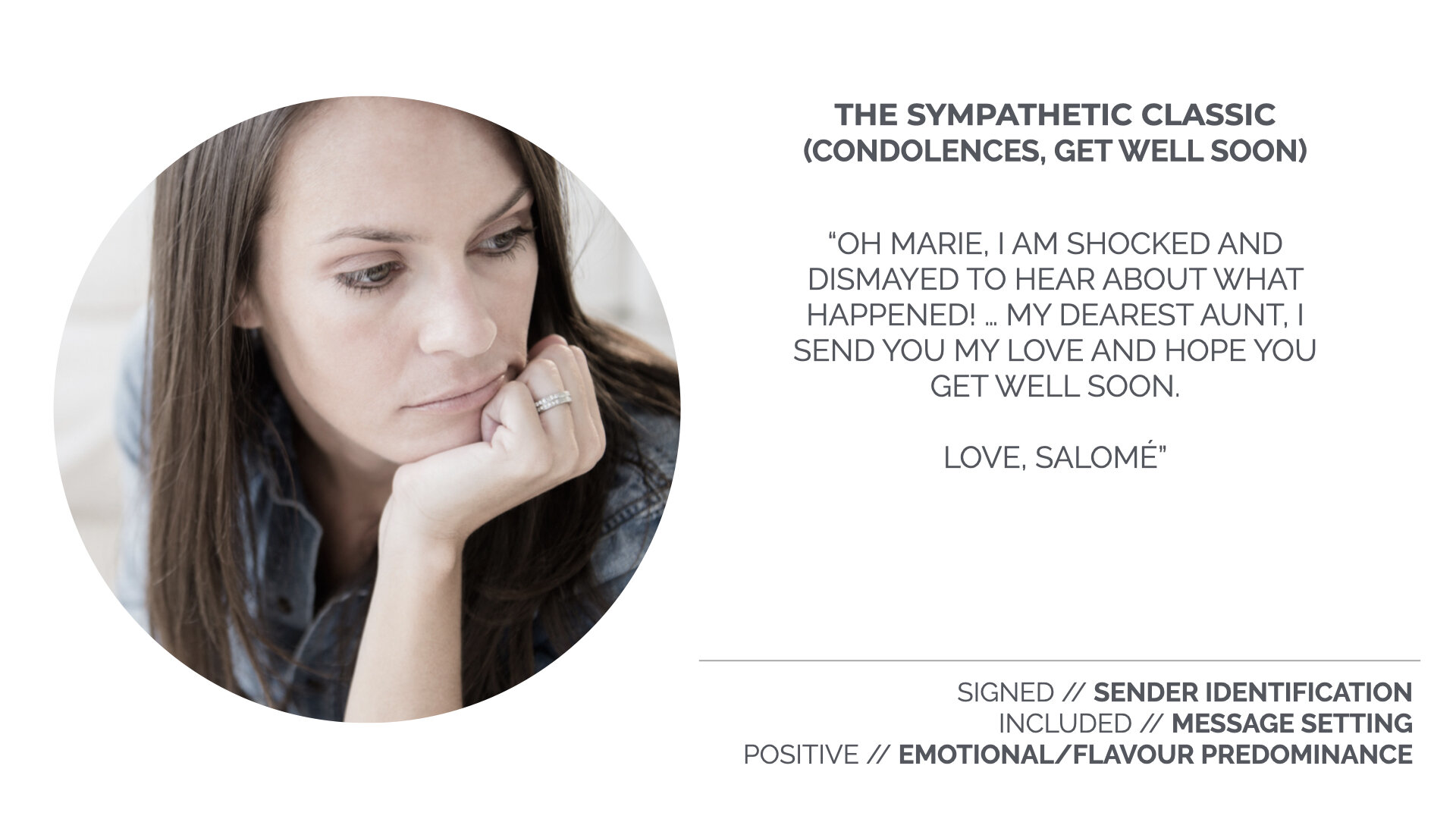
Salomé sends her aunt a warm voice message, apologising sincerely for not being able to make it soon enough, and wishes that she has a speedy recovery.
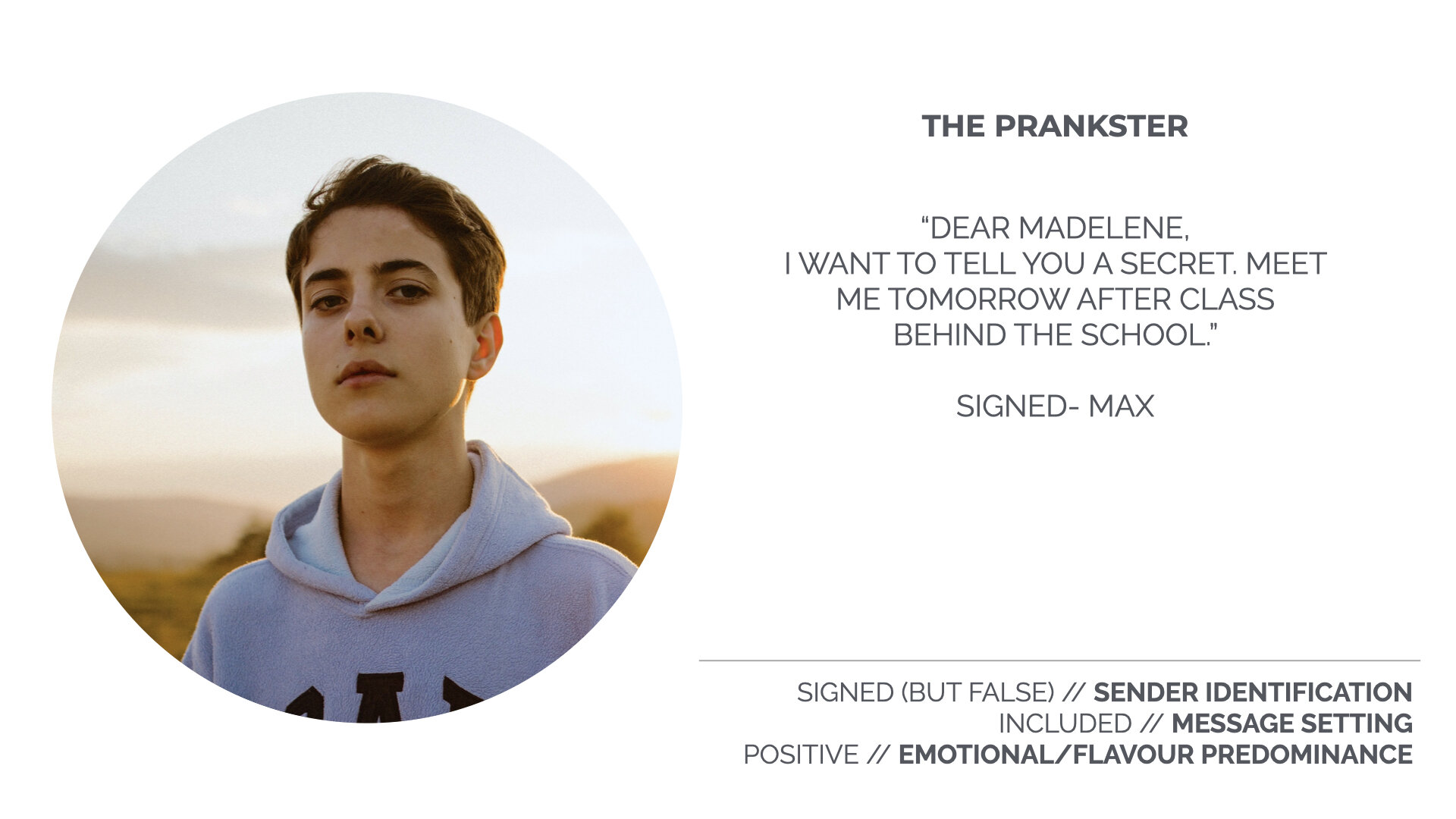
Max plays a trick on his best friend Madelene by making her think she has a secret admirer.
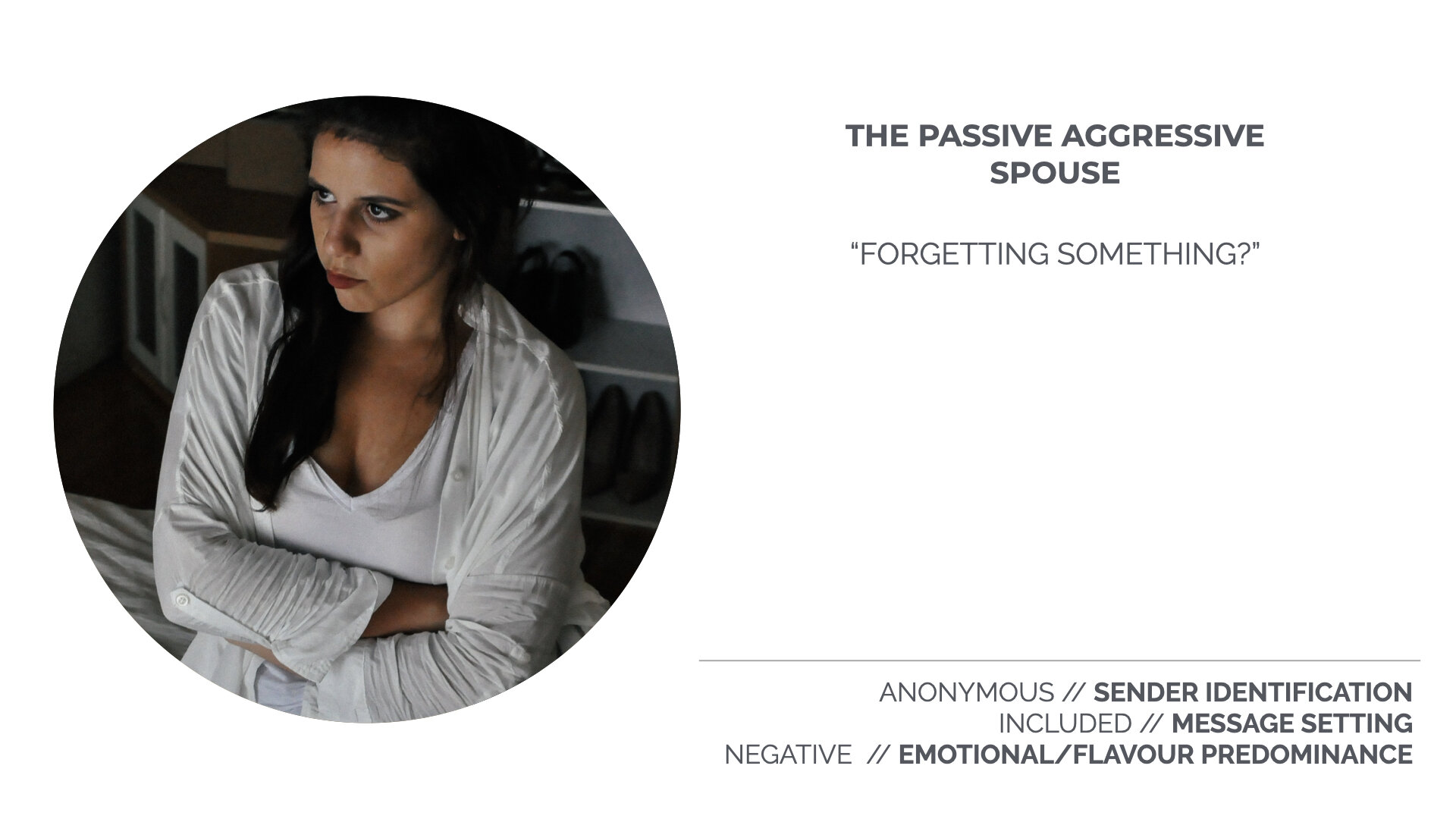
Markus forgets his and Violetta’s anniversary, so she sends him a box of émoi. He first thinks it’s just a normal gift, but as he tastes the chocolates and reads the flavour guide, he quickly realises exactly who this is from and that he’s messed something up!
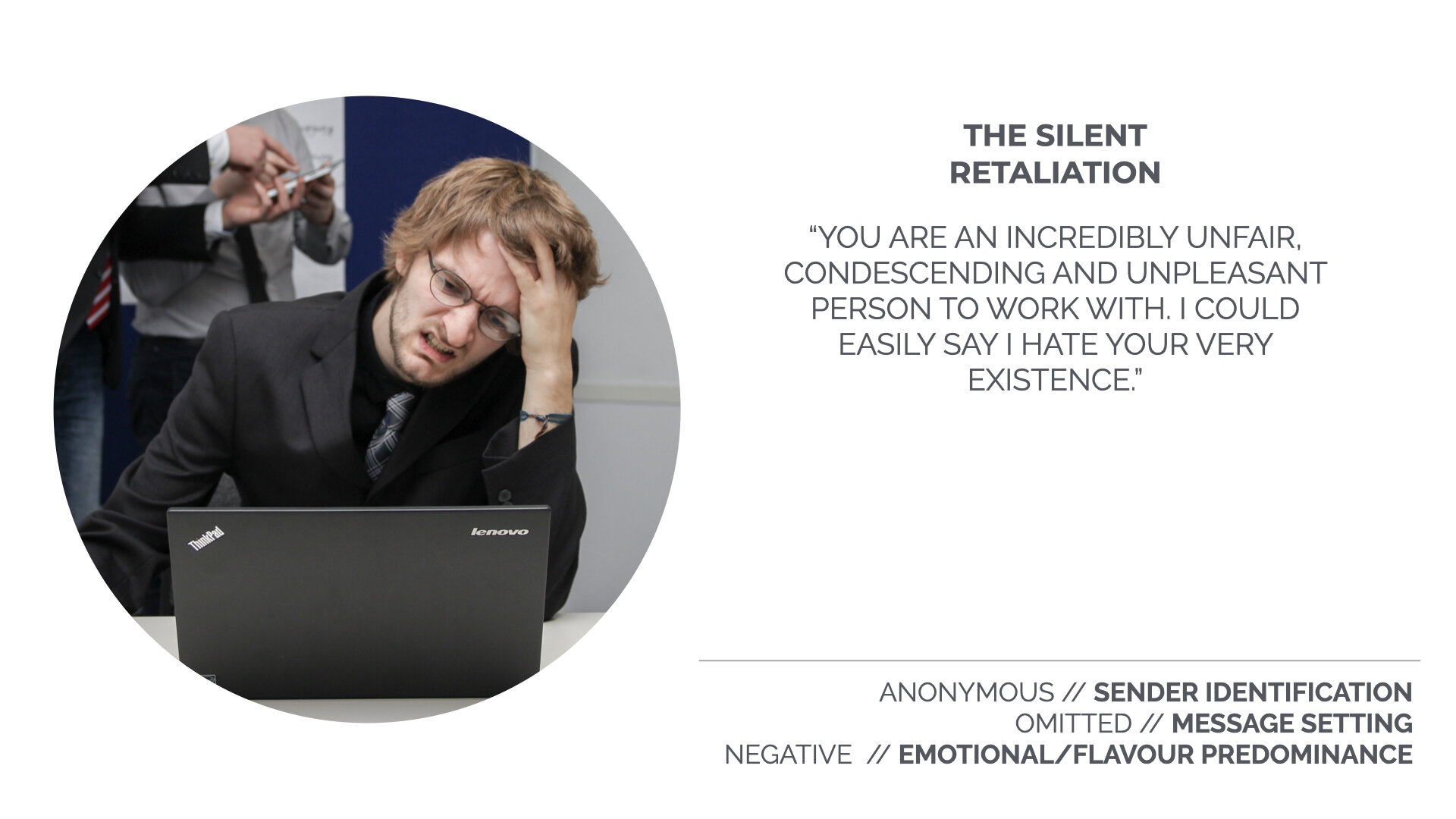
Jeff sends his boss an anonymous box of “émoi” that embodies his pent-up frustration.
Emotion to edible medium language
Emotion spectrum design
To create an emotion to flavour language, I built upon my research in previous iterations by referencing and combining some of the most widely used emotion categorization frameworks in psychology today.
The basic Geneva Emotion wheel (center) is interesting because it clearly separates between negative and positive sentiments in a way that would be easily understandable by the user.
The leftmost diagram, created by Robert Plutchik is one of the most popular frameworks in use - particularly in sentiment analysis algorithms today. What is most interesting in this version is that it attributes names to emotional intensity levels. For example, in the diagram, annoyance, anger and rage are different levels of the same emotion. This is valuable in using common terms to help the user identify a wide spectrum of feelings.
The right most diagram is a modified version of the Geneva Emotion Wheel. It is interesting because it includes a much wider variety of possible emotions for a user to select from, while the Geneva Emotion Wheel can in this sense be limiting.
I also used lists of common terms for feelings and emotions found on cncv.org and psychpage.com to outline the sentiments involved in the scenarios described above and then matched the emotions along the spectrum. Based on this, I created a new system that could work as the basis of the émoi emotion to flavour language.
The result is this relatively comprehensive diagram. I used the Plutchik manner of using different terms for the intensities. And I also attempted to incorporate attitudes and emotions involved in interpersonal contexts. I also sectioned out feelings using positive and negative definitions of the spectrum.
3 of the most widely used emotion categorization systems.
A system I created for my project based on common emotion categorization methods.
Emotion to chocolate design
Using the intensity and the positive to negative sectioning of the emotion spectrum I defined, I created a language that portrays intensity using texture, and the positive/mixed/negative sections using shape. The shapes are based on the aforementioned research into the “Bouba/Kiki effect”, where the sharp, angular square shape represents negative emotions, the smooth, circular shape represents positive emotions, and the combination shape represents combination emotions.
The texture also serves to provide a secondary identification of the section (positive to negative). This is done by varying the texture. Positive textures use powder coating, mixed positive and negative sections use granules and negative sections use nuts. The choice of these textures is also based on the same “Bouba/Kiki” concept, with powders embodying the smooth element (ie. bouba) and the crunchy, irregular nuts embodying the sharp and angular elements (ie. kiki).
Most of the flavours selected are based on chocolate ingredients already in use in artisan’s ateliers, as found in my research of chocolatiers in and around Geneva and Vaud areas of Switzerland. Others are intentionally selected to be discordant and unusual (particularly in the negative section). However, the intensity of the flavour is constant and does not vary with the emotional intensity.
These flavours were defined with the help of a Geneva based of a hotelier consultant and chef.
Chocolate presentation and emotion combinations
The system allows the user to define flavours for a total of 12 chocolates in a box. The user can choose a maximum of 4 emotions, and a minimum of one. This means that all the chocolates in a box can represent one emotion only, or as much as 4 discrete emotions.
Assuming that the user has selected 2 or more emotions for his/her box, they can then define the dominance of the emotion, which will be reflected as the number of instances of that flavour in this box. For example, in “the sympathetic classic” (condolences, get well soon) scenario described previously, the user might select three emotions: sadness, shock, and sympathy. The user can then choose to have the chocolate representing sympathy to occur eight times in the box (two thirds) while sadness and shock each take up two of the remaining four chocolates.
In cases where the user has selected 2 or more emotions for his/her box, they can then define the dominance of the emotion, which will be reflected as the number of instances of that flavour in this box. For example, in “the sympathetic classic” (condolences, get well soon) scenario described previously, the user might select three emotions: relief, sadness, and sympathy. The user can then choose to have the chocolate representing relief to occur eight times in the box (two thirds) while sadness and sympathy each take up two of the remaining four chocolates.
User and system flow
The complete journey starts with the user’s need to communicate a message. They follow this by accessing the system interface to make an order, or to do so in the traditional fashion in the local chocolatier shop. The chocolatier receives the order, prepares the chocolate request, prepares the box and its contents and then prepares for shipping or in-store pickup. The box is then either shipped or awaits pickup by the user. And finally the end-user (recipient) receives the product.
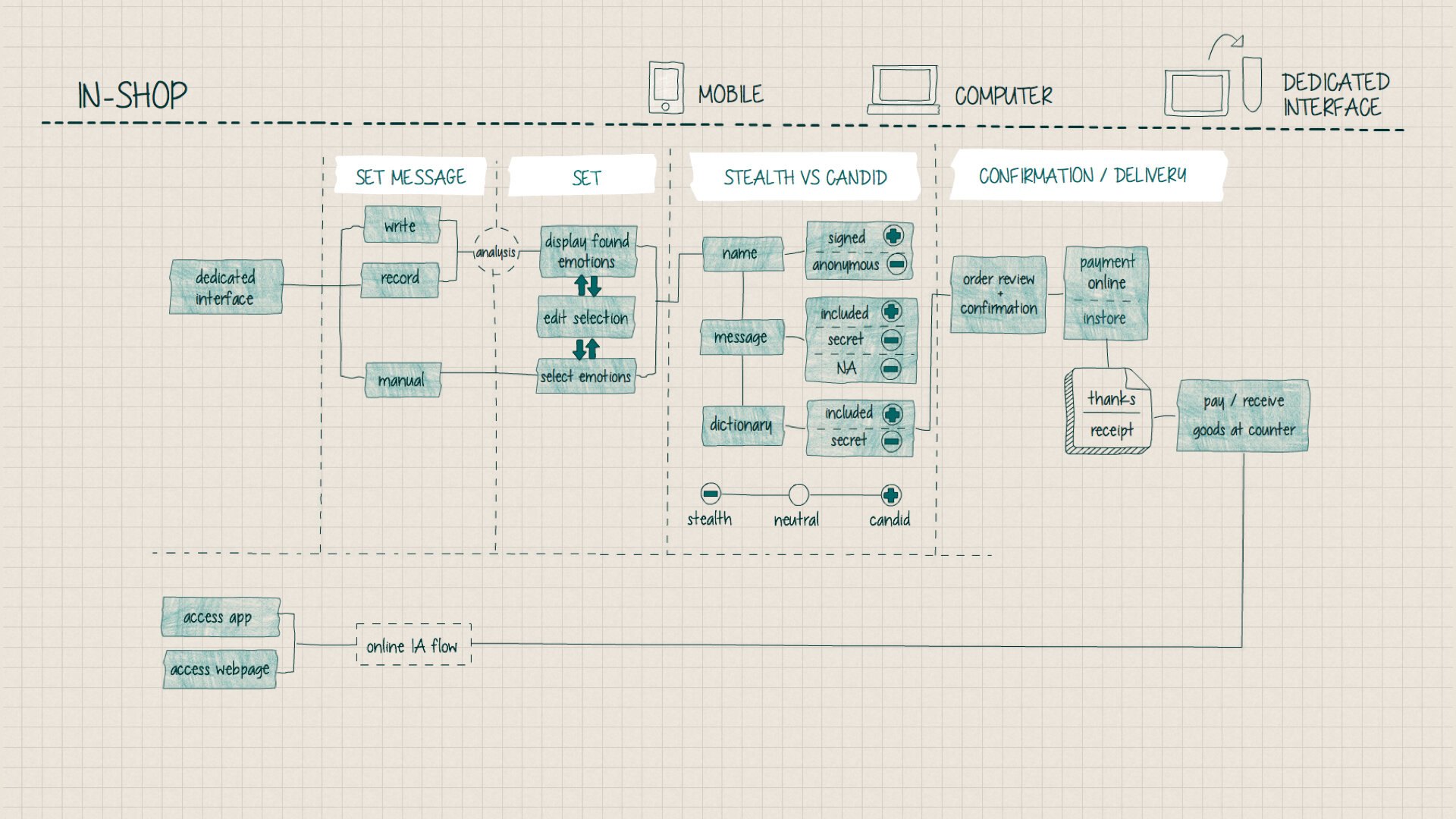
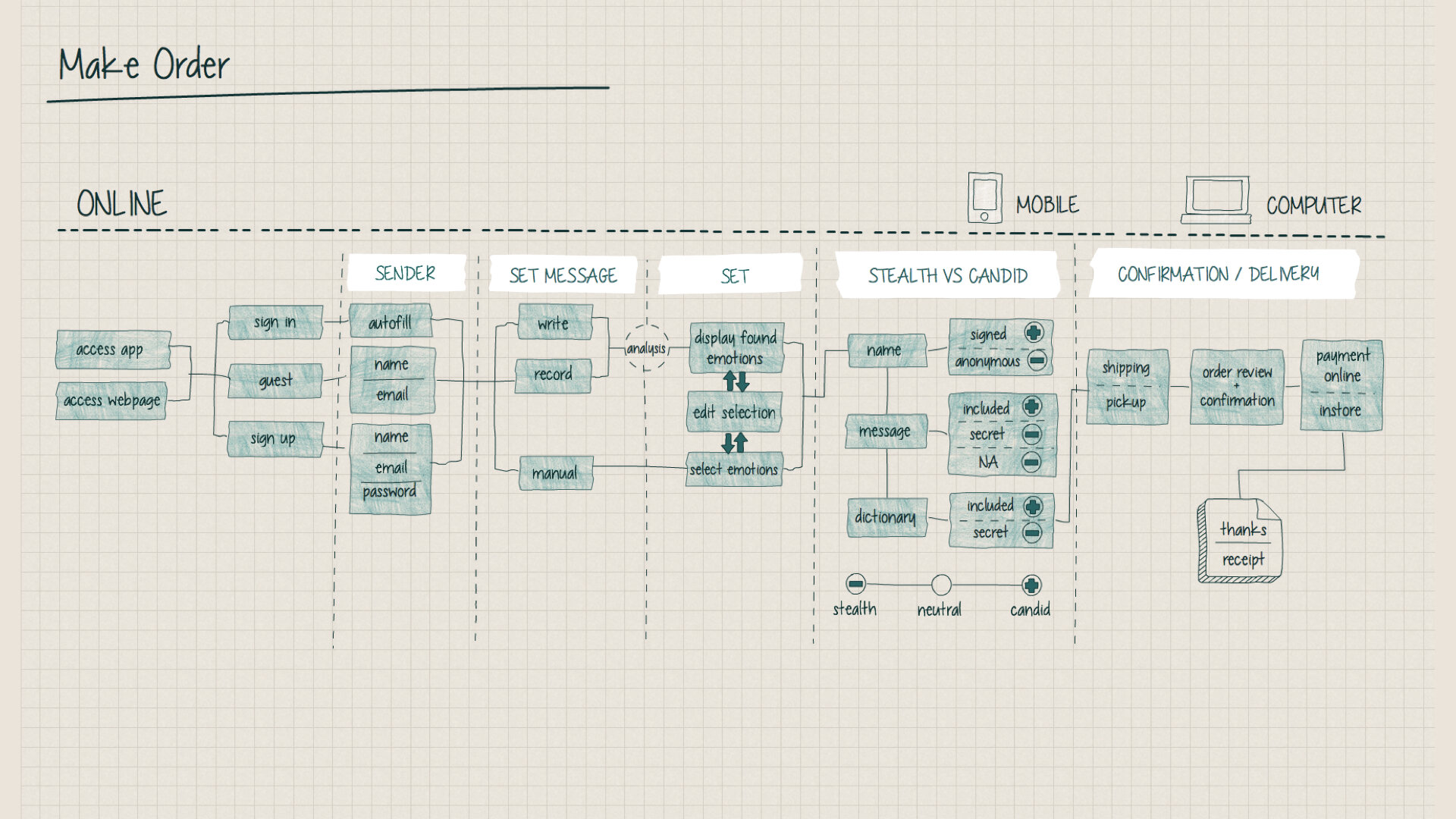
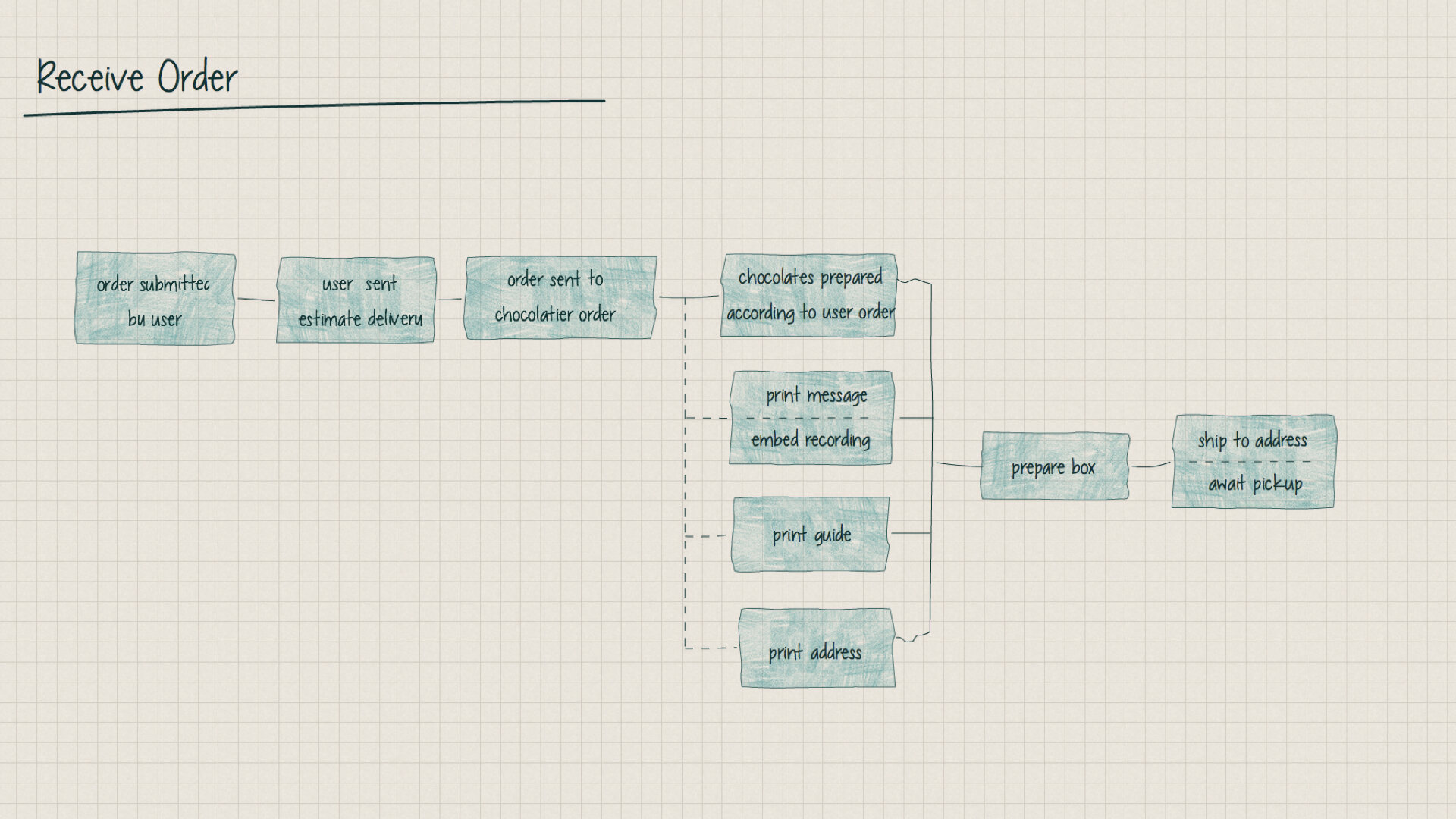
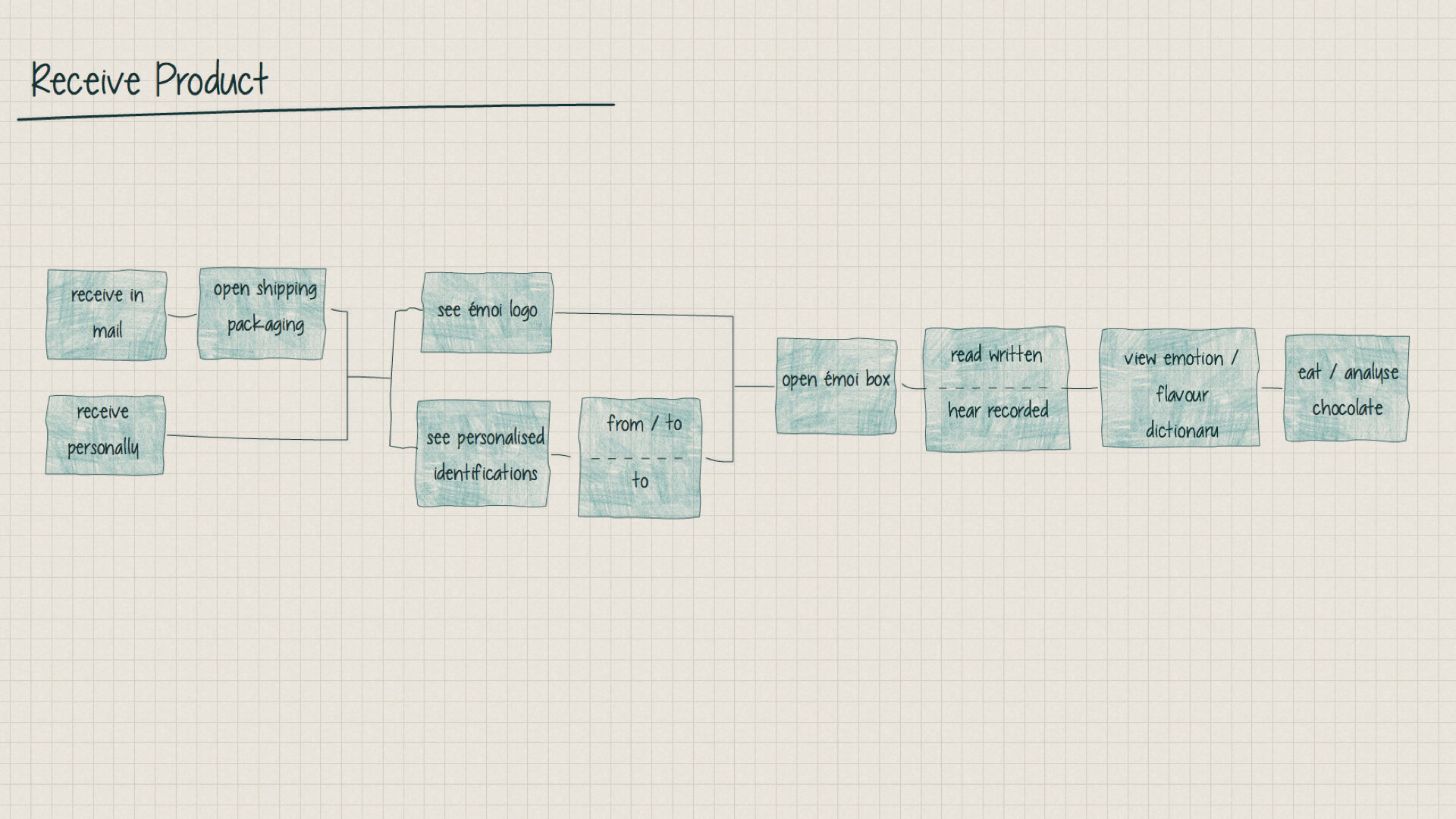
Service blueprint
Both service scenarios start in the same way with - whether in-shop or remote, access to the UI is necessary to make the order. However, beyond that, the service could be produced by a large scale and fully automated production system with minimal human intervention - ie, automatic order management and order production via dedicated industrial scale machines for chocolate and packaging production and assembly. Or it could be produced by a smaller company that preserves artisanal values but utilises modern technology like e-commerce and digital fabrication systems to facilitate their reach to a wider customer-base. Such a company values personal contact with the customer, as well as between the employee and the product. Some parts of the production process are produced by hand
UI testing
The UI tests were conducted with 3 participants
General impressions
All 3 users found interface straightforward and easy to use.
The general concept was also found to be easy to understand and applicable to real life use.
The visual design and layout was generally found to be pleasant and clear.
UI element’s functions are easy to learn and figure out - all 3 participants were able to complete tasks.
Learnings
1 participant particularly appreciated the manual input option - in case the other two options were insufficient.
1 participant suggested a new context for the “get well soon” scenario that was more applicable to her life and age group. She suggested she would use such a gift indeed as a get well soon present, but for a hung-over friend in need of a friend’s support.
2 users found the chocolate icons unclear.
1 participant said these icons did not sufficiently communicate the real product’s final outcome.
Testing UI with users.
Implementing UI modifications based on user testing.
Final screens and UI
●
The conclusions
The challenges
Some difficulties and obstacles encountered were
Working independently on a multidisciplinary project.
Working with a very limited time constraint.
Having a broad scope at the start of the project.
Let’s focus on one
Having a broad scope at the start of the project
Since the studies I referenced at the start of my research used multimodal perception as a solution to very practical problems, my first inclination was to tackle my project in the same way. I asked myself, for example, how might a person whose sight modality is already occupied benefit from this? The scenarios in this use case include multitasking while operating machinery and alongside screen dependent office work.
However, on conducting the initial phase of interviews and research, I found out that though the need for unburdening the visual perception was clear, exploring the taste modality in this context was not a good match.
Following this realisation, I sketched out various scenarios. Many of which were not impactful upon testing with users.
To make the “edible medium” more appropriate for the context, I investigated ways that food was already being used to communicate. My research showed that food is most commonly used during celebration and as a means of interpersonal communication throughout cultures and history.
On testing a scenario where the use of the taste modality is used to “display” interpersonal messages, the positive reaction from the participants was clear. The context made sense to them and the idea was novel and intriguing enough to pique their interest.
The takeaways and results
The successes were
I received the highest grade in the program for my work on this project.
The project garnered interest in multiple news outlets locally and internationally.
The project was selected to represent Switzerland at international events.
The project received awards and accolades.
A selection of the chocolates were produced by real chocolate artisans and then tested during workshops, presentations and events.
Some next steps and thoughts on how to improve the project
Considering the time constraints and the limited support and resources available to me during this project, I was very satisfied with the outcome. That being said, great things are never done alone, and I am sure that having the support of a team would have taken this project to a whole new level.
Teamwork is always invaluable.















